Victor Gruschka Springer was an American biologist who was a Senior Scientist emeritus, Division of Fishes at the Smithsonian Institution's National Museum of Natural History in Washington, D.C. He was a specialist in the anatomy, classification, and distribution of fishes, with a special interest in tropical marine shorefishes. He published numerous scientific studies on these subjects; also, a popular book called "Sharks in Question, the Smithsonian Answer Book" 1989.
Pierre Fourmanoir (1924–2007) was a French ichthyologist working mainly in New Caledonia. He described many new species of fish including several sharks.
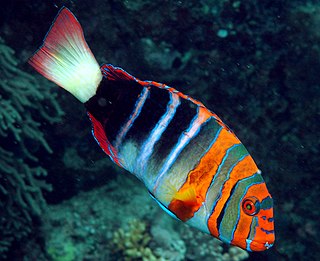
Choerodon is a genus of wrasses native to the Indian Ocean and the western Pacific Ocean. They are commonly referred to as tuskfish, because most species have sharp tusk-like teeth.

The longnose catshark is a catshark of the family Scyliorhinidae found in the eastern central Pacific from central and southern California and the Gulf of California, between latitudes 38° N and 23° N, at depths down to 1,890. Its length is up to 58 cm.
Cololabis is a genus of sauries found in the eastern and northern Pacific Ocean. The name is derived from the Greek word kolos, meaning 'short', and the Latin word labis, meaning 'forceps', referring to the short beak of the type species Scombresox brevirostris.
Gilbert Percy Whitley was a British-born Australian ichthyologist and malacologist who was Curator of Fishes at the Australian Museum in Sydney for about 40 years. He was born at Swaythling, Southampton, England, and was educated at King Edward VI School, Southampton and the Royal Naval College, Osborne.
George Sprague Myers was an American ichthyologist who spent most of his career at Stanford University. He served as the editor of Stanford Ichthyological Bulletin as well as president of the American Society of Ichthyologists and Herpetologists. Myers was also head of the Division of Fishes at the United States National Museum, and held a position as an ichthyologist for the United States Fish and Wildlife Service. He was also an advisor in fisheries and ichthyology to the Brazilian Government.
Rhabdoblennius is a genus of combtooth blennies found in the Pacific Ocean, mostly in the western Pacific. The name of this genus is derived from the Greek word rhabdos meaning "stick" or "rod" and blennius meaning "mucus", referring to the absence of scales on the body of blennies.
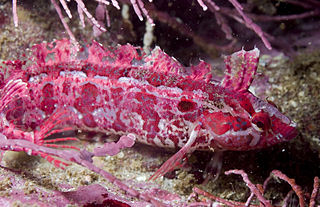
Gibbonsia is a genus of clinids native to the eastern Pacific ocean. The name of this genus honours the American naturalist, physician and founder member of the California Academy of Sciences, William P. Gibbons (1812-1897).
Peter Robert Last is an Australian ichthyologist, curator of the Australian National Fish Collection and a senior principal research scientist at CSIRO Marine and Atmospheric Research (CMAR) in Hobart, Tasmania. He is an elasmobranch expert and has described many new species of shark.
Gerald Robert "Gerry" Allen is an American-born Australian ichthyologist. His career began in 1963, when he spent a semester at the University of Hawaii, where he also received a PhD in marine zoology in 1971. In 1972, Allen wrote his doctoral thesis on the systematics and biology of the anemone fish.
John Ernest "Jack" Randall was an American ichthyologist and a leading authority on coral reef fishes. Randall described over 800 species and authored 11 books and over 900 scientific papers and popular articles. He spent most of his career working in Hawaii. He died in April 2020 at the age of 95.
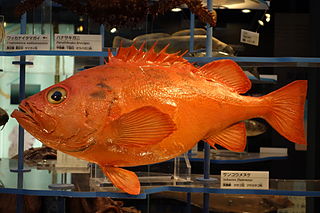
Sebastes flammeus is a species of fish in the rockfish family found in the northwest Pacific.
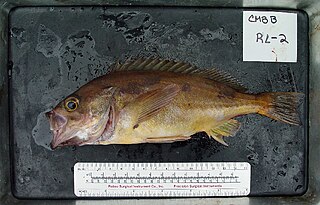
Sebastes hopkinsi, the squarespot rockfish, is a species of marine ray-finned fish belonging to the subfamily Sebastinae, the rockfishes, part of the family Scorpaenidae. This species is found in the Eastern Pacific.

Sebastes taczanowskii, the white-edged rockfish, is a species of marine ray-finned fish belonging to the subfamily Sebastinae, the rockfishes, part of the family Scorpaenidae. It is native to the northwestern Pacific Ocean from northern Japan and far eastern Russia, it has also been reported from Korea. This species was first formally described in 1880 by the Austrian ichthyologist Franz Steindachner with the type locality given as Northern Japan. The identity of the person honoutred in its specific name is not certain but is thought likely to be the Polish zoologist Władysław Taczanowski, who possibly gave Steindachner the type which had been collected by another Polish zoologist, Benedykt Dybowski. Some authorities place this species in the subgenus Mebarus.This demersal fish is found in shallow waters near coasts and will enter estuaries and the juveniles live among floating seaweed. It is an ovoviviparous species. This species attains a maximum total length of 32 cm (13 in).
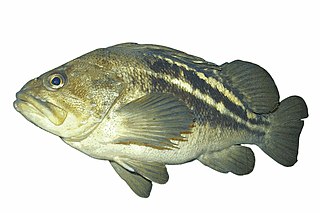
Sebastes trivittatus, the threestripe rockfish, is a species of marine ray-finned fish belonging to the subfamily Sebastinae, the rockfishes, part of the family Scorpaenidae. It is native to the northwestern Pacific Ocean where it has been recorded from Japan and Korea. This species was first formally described in 1880 by the German zoologist and paleontologist Franz Martin Hilgendorf with the type locality given as Hokkaido. The specific name trivittatus means "threebanded", presumably alluding to the three stripes shown by living adults. Some authorities place this species in the subgenus Pteropodus. This demersal fish is found o rock coasts. It is an ovoviviparous species. This species attains a maximum total length of 62 cm (24 in), although 45.5 cm (17.9 in) and a maximum published weight of 4.7 kg (10 lb).
Helen K. Larson is an ichthyologist who specialises in the fishes of the Indo-Pacific.
Loren Paul Woods (1913–1979) was an American ichthyologist and museum curator at the Field Museum of Natural History In Chicago. He joined the museum's education department as a guide lecturer in 1938. In 1941, he was transferred to the Division of Fishes, from where he retired in 1978. His career was interrupted by a four-year period of duty with the United States Navy during World War II. While he was in the navy, Marion Griswold Grey served as the unpaid curator, becoming an associate at the museum when Woods resumed his post. During his time at the Field Museum, he assembled specimen collections of North American freshwater fish and Atlantic, Indian, and Pacific Ocean marine fish. This material resulted in a major expansion of the museum's fishes holdings, which had previously been a mostly freshwater collection. Woods is best remembered for his publications on damselfish, squirrelfish, and Berycidae.
Nikolai Vasilyevich Parin was a Soviet and Russian ichthyologist, specializing in oceanic pelagic fish. He headed the Laboratory of Oceanic Ichthyofauna at the RAS Institute of Oceanology in Moscow, where he ended his career as a Professor after more than fifty-seven years. In his career, he described more than 150 new taxa of fish and participated in 20 major oceanic expeditions. Thirty-six species of fish are named in his honour.
Eumicrotremus tokranovi is a species of lumpfish native to the Northwest Pacific, and one of two species some authorities place in the genus Microancathus. It is known from the Kuril Islands. It is distinguished from the closely related E. fedorovi by a taller body and flatter and less developed bone plaques. FishBase does not recognize the genus Microancathus,. This species was described by the Russian ichthyologist Olga Stepanovna Voskoboinikova in 2015 in the proposed new genus, Microancathus and the reclassification of M. fedorovi in that genus. Catalog of Fishes does not recognize the new genus and classifies this species in Eumicrotremus. The specific name honors the ichthyologist Alexei Mikhailovich Tokranovof the Kamchatka Branch of the Pacific Institute of Geography and the Far East Branch of the Russian Academy of Sciences.







